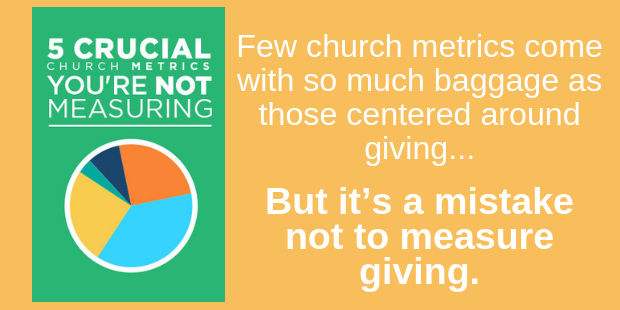
The Critical Metric You’re Not Measuring – But Should Be!
(NOTE: This post was excerpted from the ebook “5 Crucial Church Metrics You’re Not Measuring (But Should Be!)”)
Few church metrics come with so much baggage as those centered around giving. We simply don’t know how far to delve into the generosity (or lack thereof) of our congregation. Often, it comes from an honest and well-intentioned desire not to prejudice ourselves for or against people based upon how much they give.
But it’s a mistake not to measure giving. In 21st-century North America, generosity gives us a bird’s-eye view into the human heart like no other church metric. Johnny Hunt, longtime pastor of First Baptist Church of Woodstock, Georgia, puts it this way: “You’re never more like Jesus than when you give.” If Jesus is the spiritual-maturity barometer of a discipled Christian, then generosity has to be a critical part of the equation.
That’s why you want a giving metric that measures the breadth of your giving across your church membership. If your congregation as a whole isn’t giving— or giving is relegated to a relative few—you can assume you have people who need additional discipleship in the area of generosity.
“It’s incredibly valuable to know that we have 40 committed families, and we have 30 committed givers. That tells us we probably have 25 percent of our church [that] has not been discipled in that area or doesn’t have the means [to give],” said Brandon Cox, who serves as the managing editor for Pastors.com and the founding pastor of Grace Hills Church in northwest Arkansas.
Depending upon how your church tracks giving, this shouldn’t be tough to figure either. Whoever manages your accounting can simply isolate all your members’ giving records and count up the number of people who have given in the past month. Divide that number by your church’s total number of givers.
But here’s where technology can come into play and really help you see the facts and figures. We are living in a time where technology has evolved at an amazing rate, and the latest version of a computer or smartphone is outdated in a matter of months, not years. But in the church, we are often behind when it comes to technology. Whether it’s fear of change or an overwhelming number of options to choose from, decisions about technology seem to paralyze church leaders into indecision. Technology can be an extremely beneficial element to your ministry, particularly when it comes to generosity.
Did you know that the percentage of people using their smartphones to shop on Amazon cracked the 70 percent mark in December of 2015? Facebook sees similar mobile use. In fact, in April of 2016, Facebook reported that 79 percent of its advertising revenue came through mobile ads.
There are even articles being published on the importance of mobile giving for churches that cite some very important metrics, such as, 3 Reasons Why Your Church Needs to Consider Mobile Giving for Offering & Tithes.
At the end of the day, when it comes to trends like this, the numbers don’t lie.
My point of sharing these metrics is that the world today regularly interacts via smartphone, and that number is only growing as smartphones become more and more integrated into our daily lives. If your church is not taking advantage of this shift, you are not only missing out on connecting more with your community, but you are also missing out on the valuable metrics that come with it. These metrics can help measure the percentage of members who give, determine how effective and useful your current technology is, and make educated decisions about how well your technology serves your ministry.
What does this metric tell you? You’ll learn how well you’ve discipled your congregation in the area of generosity.
Things to Consider:
- Obviously, if you have a high percentage of members who give in cash, this metric becomes very difficult to figure. Platforms like Pushpay can help with this by consistently driving your congregation to mobile giving. Churches that have adopted Pushpay technology have received 76 percent of their giving through mobile technology on average—that alone can give you a lot of data.
- Everyone who gives between $1 and $10,000 in a given month will count toward this figure. You can’t determine how well your members understand the concept of tithing through this metric. Couple it with per capita giving to understand the breadth and depth of giving in your congregation.
- Remember the cautions described earlier about numbers related to church membership. Make sure you have accurate church membership figures. (That goes for any of the metrics in related to church membership).
How to Improve This Metric:
Get plugged into a mobile giving solution. We live in a mobile world where your congregants expect to be able to give on the run. By encouraging mobile giving, this platform can increase the number of people in your church who give—and how quickly they give after joining your church.
- Develop a comprehensive plan to teach stewardship to your congregation. Preach about stewardship on an annual basis at a minimum. Offer classes that help your members get on top of their debt.
To learn more about this and other oft-overlooked church metrics, click to read the rest of the ebook!

Tags: Church Giving, Metrics for Church Giving, PushPay, church giving metrics













